Germany’s beer culture represents over 500 years of brewing excellence, setting the global standard for quality, tradition, and innovation. When you think of world-class beer, Germany immediately comes to mind—and for good reason. This comprehensive guide explores everything from the legendary Reinheitsgebot purity law to the best german beers you can find today, covering traditional german beer styles, top german breweries, and the cultural heritage that makes Germany the ultimate beer destination.
Whether you’re planning a trip to Munich for Oktoberfest, exploring craft beer stores for authentic German lagers, or simply wanting to understand what makes german beer so exceptional, this guide provides the complete picture of Germany’s brewing excellence.
German Beer Culture and the Reinheitsgebot Purity Law
Germany’s beer culture dates back to medieval times, with monasteries serving as the epicenters of brewing innovation and quality control. These religious institutions refined brewing techniques and established many of the traditional methods still used by german breweries today. The deep-rooted history of brewing in Germany extends back over 1,000 years, creating a cultural foundation that treats beer not just as a beverage but as an integral part of daily life and social interaction.
The german beer purity law, known as the Reinheitsgebot, stands as the world’s oldest food safety regulation, established in 1516 in Bavaria. This groundbreaking law originally allowed only three ingredients in beer production: water, hops, and malt (yeast was added later once its role was understood). The defining characteristic of authentic german beer remains this strict adherence to natural ingredients, ensuring consistent quality and taste that has made Germany’s beer reputation legendary worldwide.
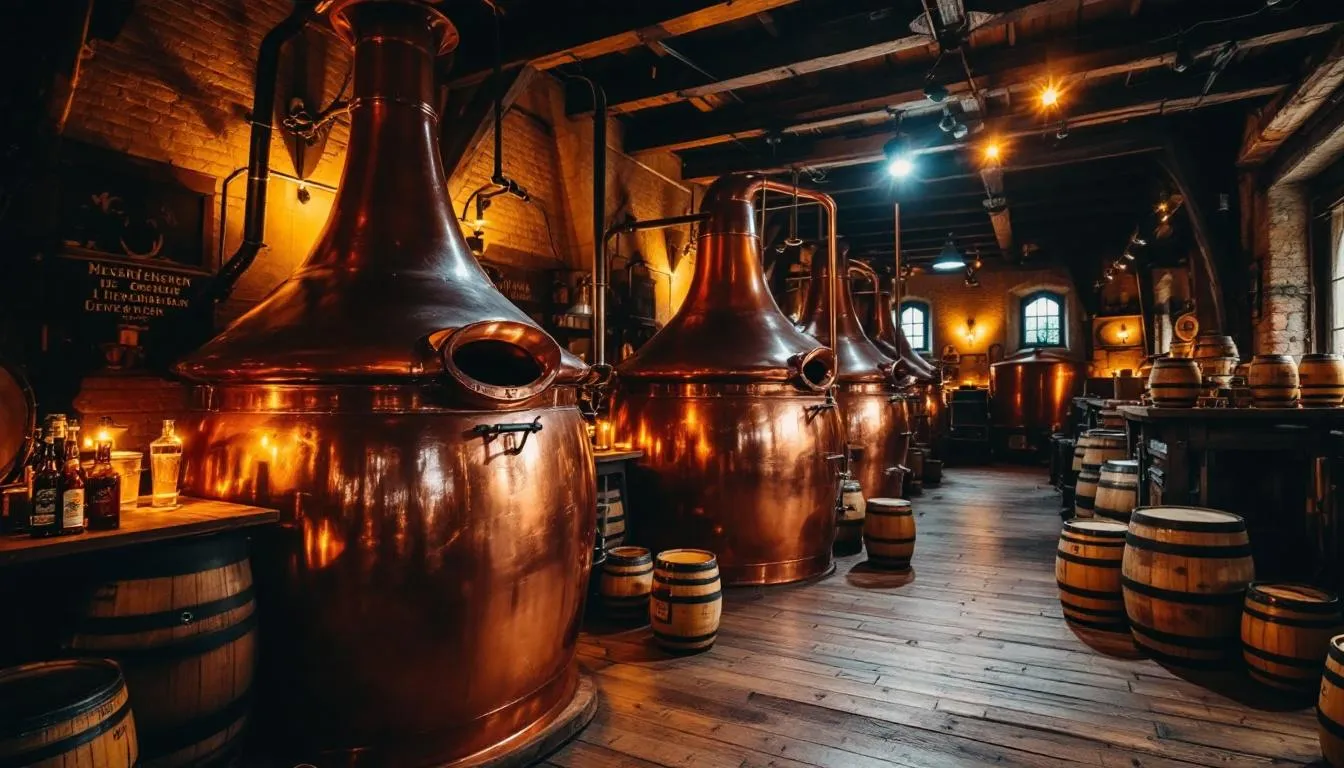
Germany currently ranks as Europe’s third-largest per-capita beer consumer and the world’s fourth-largest beer exporter in 2023, producing over 95 million hectoliters annually. This massive production comes from more than 1,500 active breweries across the country, most of which are small, family-owned operations that have been brewing for generations. The german breweries maintain traditional brewing methods while incorporating modern quality control and distribution systems.
Regional brewing traditions vary significantly across Bavaria, North Rhine-Westphalia, and other German states. Bavaria remains the heart of german beer culture, home to Oktoberfest and many of the world’s most famous beer styles. North Rhine-Westphalia contributes distinctive ales like Kölsch and Altbier, while other regions have developed their own specialties that reflect local tastes and ingredients. Each region takes pride in its unique brewing heritage, creating a diverse landscape of beer styles that showcase Germany’s brewing expertise.
The traditional brewing methods employed by german breweries include step mashing and decoction mashing techniques that maximize flavor extraction and create the clean, crisp profiles associated with german lager and other styles. These time-tested processes, combined with Germany’s abundant high-quality water sources and the world’s largest hop-growing region in Hallertau, create the foundation for consistent brewing excellence.
Essential German Beer Styles
German beer styles represent centuries of brewing refinement, with each style carefully crafted to showcase specific ingredients and techniques. Understanding these styles helps beer enthusiasts appreciate the diversity and complexity of Germany’s brewing heritage.
German Lagers
German lagers form the backbone of the country’s beer production, utilizing bottom-fermenting yeast strains that create clean, crisp flavors. These beers undergo extended cold storage periods called lagering, which smooths harsh flavors and creates the refreshing character that makes german lager styles so popular worldwide.
Pilsner stands as Germany’s most internationally recognized style, featuring a crisp, hoppy character with a pale golden appearance. German pilsners typically contain 4.5-5.2% alcohol content and offer a lighter, drier taste profile compared to their Czech counterparts. The style originated in the Czech Republic but was perfected by German brewers who created more hop-forward versions using Noble German hops. These pilsners pour with brilliant clarity and maintain a persistent white foam head, making them ideal refreshing beers for warm weather.
Helles represents Munich’s answer to pilsner, creating a malt-forward pale lager with subtle hop character and 4.7-5.4% abv. This style emphasizes bread-like malt flavors while maintaining the crisp lager character that defines german beer. Helles translates to “bright” in German, referring to its pale color and clean taste. The style gained popularity as a lighter alternative to darker Munich beers, appealing to drinkers who wanted something refreshing but more malty than pilsner.
Märzen/Oktoberfest beer showcases the amber-colored festival style with toasty malt flavors and 5.2-6% alcohol content. Originally brewed in March (März) and stored in cool caves during summer months, this style became the traditional beer served at Munich’s Oktoberfest celebration. The amber color comes from Vienna malt, while the flavor profile balances caramel sweetness with moderate hop bitterness. Modern Oktoberfest beers maintain this traditional character while using contemporary brewing techniques.
Schwarzbier, literally meaning “black beer,” demonstrates how dark malts can create complex flavors while maintaining a light body. Despite its dark appearance, schwarzbier typically contains only 4.4-5.4% abv and drinks surprisingly light and refreshing. The roasted malt character provides coffee and chocolate notes without the heaviness associated with stouts or porters. This style represents one of Germany’s oldest beer traditions, with roots dating back over 500 years.
Dunkel offers another take on dark Munich lager, featuring bread-like malt character and 4.5-6% alcohol content. The style uses Munich malt to create rich, toasty flavors while maintaining the clean lager fermentation profile. Dunkel beers pour with deep amber to brown colors and emphasize malt sweetness balanced by mild hop bitterness. Traditional examples showcase smooth, drinkable profiles that pair excellently with hearty German cuisine.
Bock Beer Varieties
Bock beers represent Germany’s strongest traditional lagers, originally brewed by monks for sustenance during religious fasting periods. These malty lager styles showcase the brewing prowess of german breweries through complex flavor development and higher alcohol content.
Traditional Bock features strong amber-brown color with 6-7% abv and rich malty sweetness. The style originated in the northern German city of Einbeck before spreading throughout Bavaria. Ein bock literally means “one goat,” referring to the beer’s strength. These beers emphasize caramel and toasted bread flavors while maintaining clean lager character. Traditional bock beers mature for extended periods, developing smooth, complex profiles that warm the drinker during cold months.
Maibock represents the spring seasonal version that’s lighter in color and more hop-forward than traditional bock styles. These beers typically appear in May (Mai), offering a fresher take on strong lager brewing. Maibock combines the strength of traditional bock with increased hop character and pale malt flavors, creating more approachable strong beers for warmer weather consumption.
Doppelbock showcases monastic-style strong beer with 7-12% alcohol content, dark color, and intense caramel-chocolate notes. The name literally means “double bock,” though it refers to strength rather than doubling ingredients. These powerful beers were originally brewed by monks as “liquid bread” during Lent fasting periods. Modern doppelbock styles maintain this tradition of rich, sustaining flavors while offering some of the highest alcohol content found in traditional german beer styles.
Eisbock represents the most concentrated beer style, achieved by freezing traditional bock and removing ice crystals to concentrate flavors and alcohol. This process can achieve 9-14% abv with incredibly intense flavors. While not commonly found, eisbock demonstrates the innovative spirit of German brewers willing to push traditional boundaries while respecting core brewing principles.
German Wheat Beers and Ales
German wheat beers and ales represent the country’s top-fermenting traditions, using ale yeasts that create fruity and spicy flavors distinct from clean lager profiles. These styles showcase how german breweries master both bottom and top fermentation techniques.
Hefeweizen stands as Germany’s most famous wheat beer, featuring a cloudy appearance from suspended yeast and proteins. This style typically contains 4.9-5.6% abv and showcases distinctive banana and clove notes created by specific hefeweizen yeast strains. The wheat beer is brewed with at least 50% wheat malt, creating a smooth, creamy mouthfeel. Traditional hefeweizen is served unfiltered, maintaining the cloudy appearance that gives the style its character. The unique yeast produces esters and phenols that create the signature flavor profile impossible to replicate with standard lager yeasts.
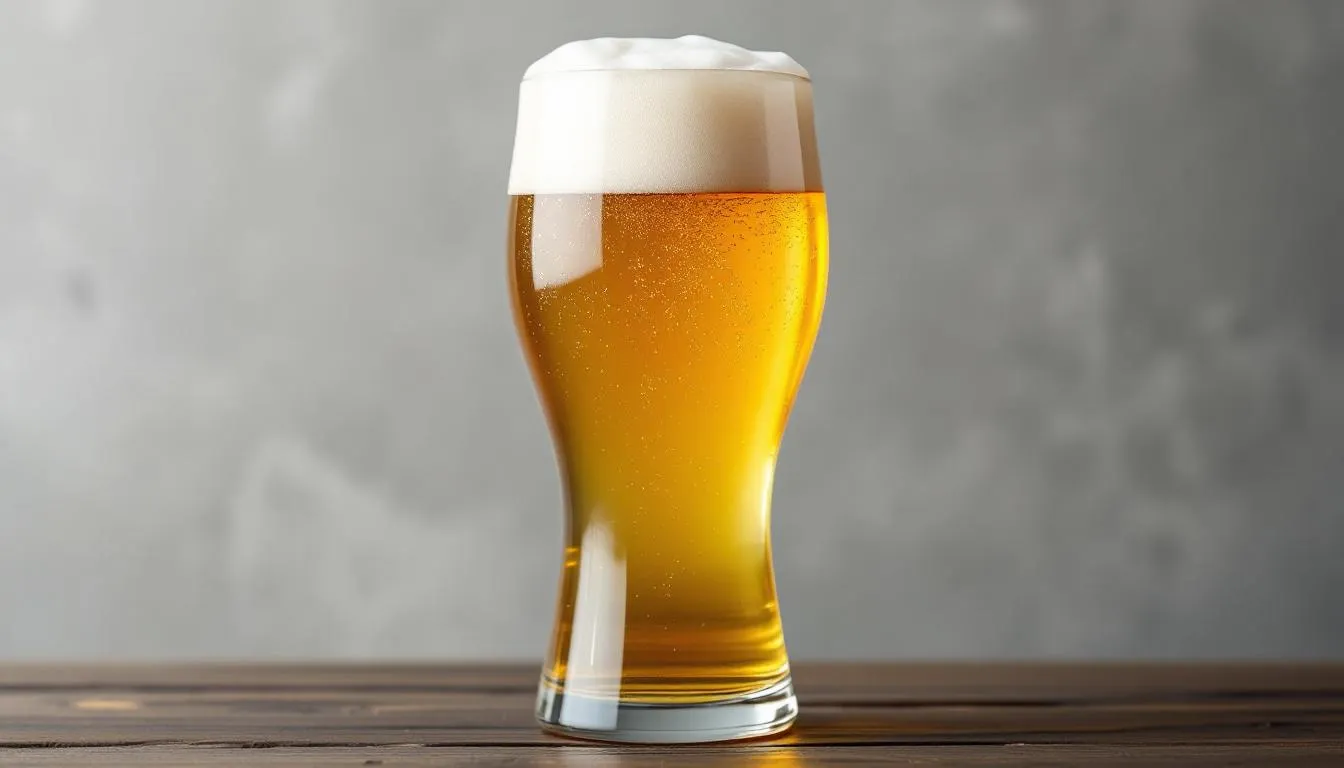
Dunkelweizen combines the banana bread flavors of wheat beer with caramel notes from darker malts. This style offers complexity beyond standard hefeweizen while maintaining the creamy wheat character. The darker malts add richness and color while the wheat beer yeast continues to produce fruity esters that complement the malty sweetness.
Weizenbock merges hefeweizen character with bock strength, creating strong wheat beers with 6.5-9% abv. These beers represent the pinnacle of wheat beer brewing, combining yeast complexity with malt richness and higher alcohol content. The style demonstrates how traditional german beer categories can be combined to create unique drinking experiences.
Kölsch offers a delicate specialty from Cologne, featuring a fruity profile with herbal hops and light body. This style enjoys protection under EU geographical designation, meaning only breweries in and around Cologne can produce authentic Kölsch. The beer serves in special 0.2-liter glass tankards called Stange, reflecting the beer’s delicate character. Kölsch represents one of Germany’s most distinctive ales, offering subtle complexity that rewards careful attention.
Altbier comes from Düsseldorf and features nutty, bready malt balanced with spicy hop character. This brown ale style represents one of Germany’s oldest beer traditions, predating the lager revolution that swept through the country. Altbier literally means “old beer,” referring to the traditional ale fermentation methods. The style offers copper to brown colors with moderate alcohol content and complex malt flavors that pair excellently with traditional German cuisine.
Sour and Specialty German Beers
Germany’s specialty and sour beer traditions demonstrate the country’s brewing diversity beyond mainstream lagers and wheat beers. These unique styles showcase innovative techniques and regional specialties that add depth to the german beer landscape.
Berliner Weisse represents a tart wheat beer with Lactobacillus sourness and low 2.8-3.8% alcohol content. This historic style from Berlin features a light, refreshing character traditionally served with flavored syrups to balance the acidity. The beer’s production involves both ale yeast and lactic acid bacteria, creating complex flavor development through mixed fermentation. Modern craft beer movements have rediscovered this traditional style, appreciating its refreshing character and food-pairing versatility.
Gose offers another sour specialty featuring salt additions and coriander spicing that creates a unique refreshing character. Originally from the Leipzig region, this style nearly disappeared before recent revivals by both German and international breweries. The slight salt content enhances the beer’s thirst-quenching properties, while coriander adds subtle spice notes that complement the lactic sourness.
Rauchbier from Bamberg showcases the use of beechwood-smoked malt, creating bacon-like flavors that challenge and delight adventurous beer drinkers. This specialty represents one of the world’s most distinctive beer styles, with only a handful of breweries maintaining the traditional smoking techniques. The style demonstrates how regional ingredients and techniques can create entirely unique flavor profiles within traditional brewing frameworks.
These specialty styles represent the innovative spirit within Germany’s traditional brewing culture, showing how german breweries continue to explore new flavors while respecting historical techniques and ingredients.
Top German Breweries and Iconic Brands
Germany’s brewing landscape features a remarkable combination of ancient institutions and modern production facilities, creating some of the world’s most respected beer brands. Understanding these key players provides insight into both the history and current state of german beer excellence.
Weihenstephaner holds the distinction as the world’s oldest continuously operating brewery, founded in 1040 AD by Benedictine monks. Located in Freising, Bavaria, this brewery produces exceptional examples of traditional german beer styles, with their Hefe Weissbier standing as the gold standard for wheat beer around the world. The brewery combines centuries of brewing knowledge with modern quality control, creating consistently excellent beers that showcase traditional German brewing at its finest. Their range includes outstanding examples of nearly every major german beer style, making them essential for anyone seeking to understand authentic German brewing.
Augustiner-Bräu represents Munich’s most beloved local brewery, known for Lagerbier Hell and maintaining traditional brewing methods that eschew modern marketing in favor of quality. Founded in 1328, Augustiner remains the oldest brewery in Munich and possibly the most respected among locals. Their beer is served at numerous traditional beer gardens throughout Munich, and many consider their Helles the benchmark for the style. The brewery’s commitment to traditional methods and local distribution creates a cult following among beer enthusiasts seeking authentic German brewing experiences.
Paulaner stands as a major Bavarian brewery famous for Hefe-Weizen and significant contributions to Oktoberfest traditions. The brewery traces its roots to 1634 and the Paulaner monks who originally brewed for sustenance. Today, Paulaner produces both traditional styles and innovative offerings while maintaining substantial international distribution. Their Oktoberfest beer represents one of the festival’s most popular offerings, and their wheat beers consistently rank among Germany’s best.
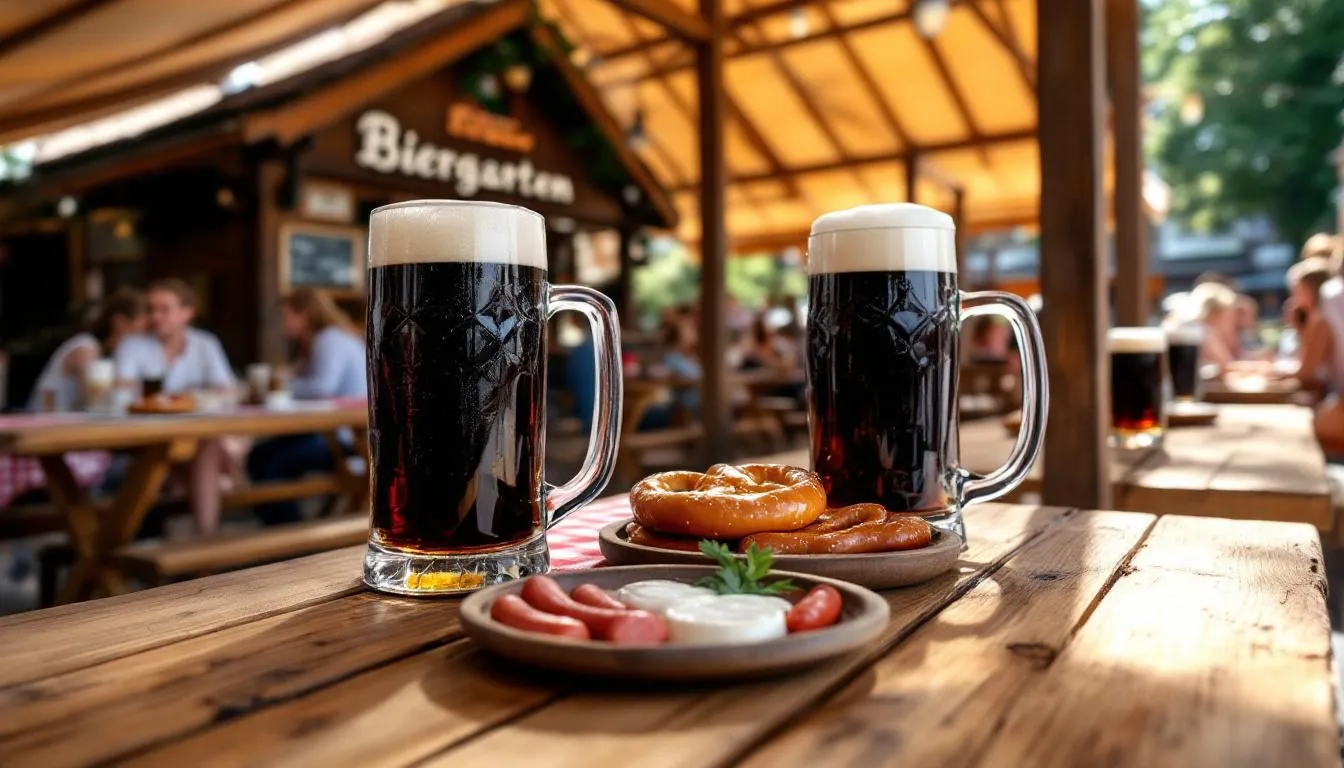
Spaten holds historical significance as the Munich brewery credited with developing Märzen style and pioneering modern lager techniques. Founded in 1397, Spaten played a crucial role in the development of bottom-fermenting lager yeasts and the techniques that made German lagers world-famous. The brewery continues to produce excellent examples of traditional styles while maintaining their role as one of the six breweries permitted to serve at Oktoberfest.
Erdinger leads the world in wheat beer production, gaining international recognition for consistent quality and wide distribution. This Bavarian brewery specializes in wheat beer styles, producing both traditional hefeweizen and innovative variations like alcohol free wheat beer. Their commitment to wheat beer excellence has made them one of Germany’s most successful beer exports, introducing people worldwide to authentic German wheat beer character.
Bitburger represents premium pilsner brewing from Rhineland-Palatinate, famous for their “Bitte ein Bit” advertising slogan and crisp lager character. Founded in 1817, Bitburger helped establish the German pilsner style that differs from Czech originals through increased hop character and cleaner fermentation profiles. The brewery’s focus on pilsner perfection has created one of Germany’s most recognizable beer brands both domestically and internationally.
Schneider Weisse continues a 150-year family tradition of wheat beer specialization, maintaining independence and traditional brewing methods. This Bavarian brewery produces some of the world’s most complex and flavorful wheat beers, including innovative styles like Schneider Weisse TAP 5 that push wheat beer boundaries while respecting traditional foundations. Their commitment to wheat beer excellence demonstrates how specialized brewing can create distinctive products that stand out in crowded markets.
Regional powerhouses like Rothaus from the Black Forest, Gaffel from Cologne, and Kostritzer from Thuringia represent local brewing excellence that showcases Germany’s diverse regional beer cultures. These breweries maintain strong local followings while producing distinctive styles that reflect their geographic origins and local preferences. Rothaus produces exceptional pilsner and regional specialties, Gaffel creates authentic Kölsch within Cologne’s protected designation, and Kostritzer specializes in schwarzbier that demonstrates the style’s traditional character.
Oktoberfest and German Beer Culture
Munich’s Oktoberfest celebration represents the pinnacle of german beer culture, celebrating 213 years of brewing tradition since its founding in 1810. This massive festival demonstrates how beer serves as more than just a beverage in German society—it functions as a cultural institution that brings people together and celebrates regional identity. The festival attracts over 6 million visitors annually, who consume more than 7 million liters of beer served exclusively by Munich breweries.
Only six major Munich breweries receive permission to serve beer at Oktoberfest: Augustiner, Hofbräu, Löwenbräu, Paulaner, Spaten, and Franziskaner. These breweries must brew their Oktoberfest beer according to strict guidelines, maintaining the traditional Märzen style that defines the festival’s drinking experience. Each brewery operates large tents that accommodate thousands of visitors, creating communal drinking experiences that epitomize German beer culture’s social aspects.
Traditional beer gardens (Biergärten) throughout Germany serve beer in 1-liter Maß steins under chestnut trees, creating outdoor social spaces that encourage community interaction. These venues originated as brewery cooling cellars where beer was stored underground, with trees planted above to provide additional cooling. Today’s beer gardens maintain this tradition of outdoor drinking while serving as neighborhood gathering places where friends and strangers share long wooden tables and traditional German foods.
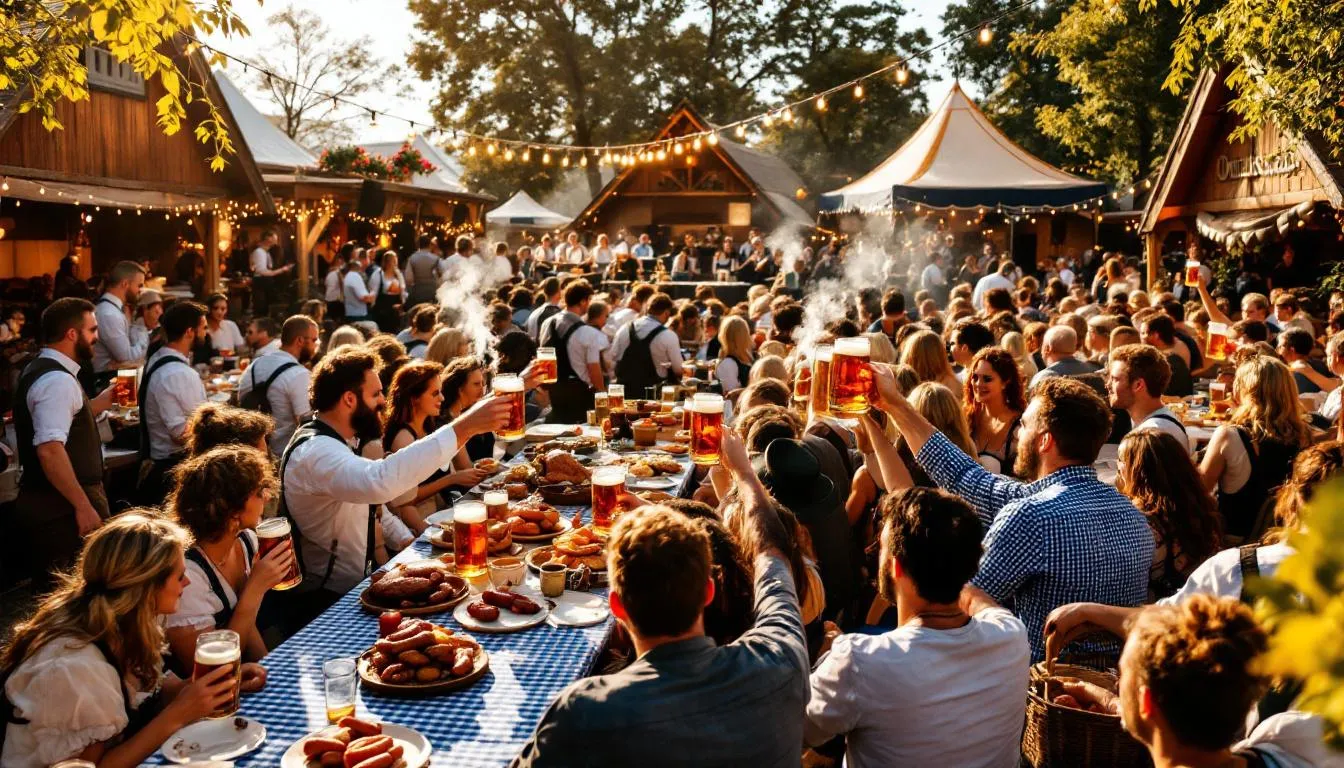
Regional beer festivals throughout Germany celebrate local brewing traditions, creating smaller-scale versions of Oktoberfest that highlight regional specialties and local breweries. These festivals range from intimate community celebrations to major events that attract visitors from neighboring regions. Each festival typically features local brewery selections, traditional foods, and cultural activities that reflect regional identity and brewing heritage.
Beer and food pairing traditions in Germany emphasize hearty combinations that complement beer’s refreshing character. Traditional pairings include pretzels with salt crystals that enhance beer’s flavor, various sausages that provide protein richness, and roasted meats that balance beer’s hoppy bitterness. These combinations developed over centuries as breweries and restaurants learned which foods best complement different beer styles and enhance the overall drinking experience.
The modern craft beer movement in Germany builds upon traditional foundations while exploring new flavor combinations and brewing techniques. German craft brewers generally work within Reinheitsgebot constraints, focusing on innovative hop varieties, specialty malts, and creative interpretations of traditional styles rather than completely new approaches. This movement demonstrates how Germany’s brewing culture continues evolving while respecting historical foundations that made german beer world-famous.
Serving and Storing German Beer
Proper serving and storage techniques significantly impact the enjoyment of german beer, with temperature control and glassware selection playing crucial roles in showcasing each style’s intended character. Understanding these factors helps both casual drinkers and serious enthusiasts maximize their appreciation of Germany’s brewing excellence.
Optimal Serving Temperatures
Different german beer styles require specific serving temperatures to showcase their best characteristics and provide optimal drinking experiences. Temperature affects everything from aroma release to carbonation perception, making proper serving crucial for authentic enjoyment.
Light lagers including Pilsner, Helles, and Kölsch perform best when served at 38-42°F, providing maximum refreshment and crisp character. These styles benefit from cold temperatures that enhance their clean, refreshing profiles while maintaining sufficient carbonation to support their delicate flavors. Serving these beers too warm diminishes their refreshing qualities, while serving too cold can suppress their subtle hop and malt characters.
Wheat beers and medium-bodied styles including Hefeweizen, Dunkelweizen, and traditional Bock require slightly warmer serving temperatures of 44-50°F to enhance yeast character and allow complex flavors to develop. Wheat beer particularly benefits from this temperature range, which allows the signature banana and clove notes to express themselves fully while maintaining the style’s creamy mouthfeel. These temperatures also help cloudy wheat beers maintain their characteristic appearance and texture.
Strong beers including Doppelbock, Weizenbock, and specialty styles perform best at cellar temperature of 50-55°F, allowing complex flavors to unfold and alcohol warmth to integrate smoothly. These temperatures help strong beers avoid alcohol harshness while allowing malty sweetness and complex fermentation flavors to shine. Serving strong beers too cold can suppress their rich character, while excessive warmth can emphasize alcohol heat at the expense of flavor balance.
Proper glassware selection enhances serving by concentrating aromas and presenting beer’s visual characteristics appropriately. Wheat beer glasses feature tall, thin shapes that accommodate large foam heads and showcase cloudy appearance. Traditional tall pilsner glasses emphasize clarity and maintain carbonation while concentrating hop aromas. Glass tankards and steins provide authentic cultural experiences while offering practical advantages like thermal mass that helps maintain temperature.
Storage Guidelines
Proper storage significantly extends beer freshness and maintains intended flavor profiles, with different styles requiring varying approaches based on their alcohol content and aging potential.
Light beers including Pilsner, Helles, and Schwarzbier should be consumed within 4-6 months of production for optimal freshness, as these styles emphasize delicate flavors that deteriorate over time. These beers benefit from consistent cold storage and protection from light exposure, which can create off-flavors and diminish hop character. The light body and lower alcohol content of these styles provide less protection against oxidation and other aging effects.
Higher alcohol styles including Doppelbock, Weizenbock, and Eisbock can age 12+ months with proper storage, sometimes improving through extended cellaring that allows flavors to integrate and mellow. These styles benefit from the preservative effects of higher alcohol content and often develop additional complexity through careful aging. Some collectors specifically age strong German beers to observe how they evolve over time.
Store all german beer in cool, dark conditions away from temperature fluctuations that can accelerate aging and create flavor instability. Ideal storage temperature ranges from 45-55°F with minimal light exposure and stable humidity levels. Temperature swings cause expansion and contraction that can affect carbonation levels and introduce oxygen that degrades flavor quality.
Vertical storage works best for bottles to minimize oxidation and maintain carbonation levels by keeping sediment settled and reducing surface area exposed to oxygen. This position also helps maintain proper carbonation by keeping the cap seal tight and preventing CO2 loss. Cans generally store well in any position but benefit from the same temperature and light controls as bottles.
Where to Buy Authentic German Beer
Finding authentic german beer requires knowing where to look and what to expect, with various sources offering different advantages for accessing Germany’s diverse brewing traditions. Understanding these options helps beer enthusiasts build collections and explore new styles effectively.
Specialized online retailers offer curated german beer selections with expert knowledge and careful shipping practices that maintain beer quality during transport. These retailers typically stock both popular brands and rare specialty beers that aren’t available through mainstream channels. Many online shops provide detailed descriptions and serving suggestions that help customers understand what they’re purchasing and how to enjoy it properly. Recent years have seen significant growth in online beer retail, making it easier than ever to access authentic German brewing from anywhere in the world.
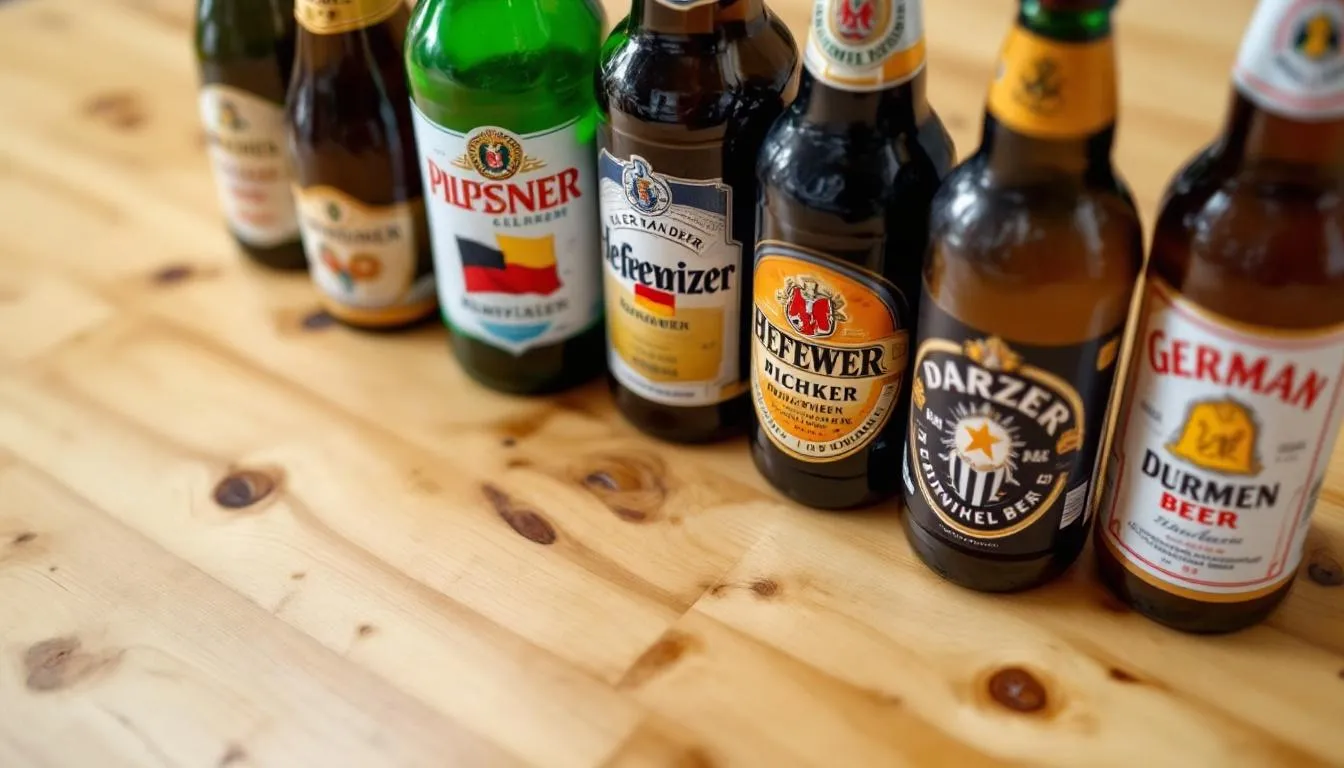
German import shops and European delicatessens in major cities typically maintain refrigerated sections dedicated to beer alongside traditional German foods that pair excellently with various styles. These shops often stock seasonal offerings and limited releases that showcase the diversity of german breweries. Staff at these locations frequently possess extensive knowledge about German brewing traditions and can provide recommendations based on customer preferences and intended food pairings.
Beer festivals and Oktoberfest celebrations throughout the world feature authentic German breweries and provide opportunities to taste multiple styles in festive environments. These events often include brewery representatives who can provide insight into brewing techniques and style characteristics. Many festivals offer special releases or rare beers that aren’t available through normal retail channels, making them valuable for beer enthusiasts seeking unique experiences.
Craft beer stores with dedicated German sections and knowledgeable staff provide another excellent source for authentic german beer, particularly in areas with strong beer cultures. These shops typically curate their selections based on quality and authenticity rather than simply stocking the most popular brands. Staff knowledge often extends beyond basic brand recognition to include understanding of brewing techniques, serving suggestions, and food pairing recommendations.
Direct brewery imports and subscription services offer access to rare german beer styles and seasonal releases that showcase the ongoing innovation within traditional brewing frameworks. These services often provide detailed information about brewing techniques and brewery history that enhances appreciation of the beers. Some subscription services focus specifically on German brewing, offering monthly selections that explore different regions and styles systematically.
Restaurant and pub recommendations vary by location, but establishments with authentic German food typically maintain beer selections that complement their cuisine appropriately. Traditional German restaurants often stock both popular and specialized german beer styles, creating opportunities to experience proper food and beer pairings. Many cities feature German-style beer halls that attempt to recreate traditional drinking environments while serving authentic german beer styles.
When purchasing german beer, look for recent production dates and proper storage conditions that maintain quality. Check bottle dates when possible and choose retailers that maintain proper refrigeration and inventory turnover. Consider starting with accessible styles like Pilsner or Hefeweizen before exploring more specialized options like Rauchbier or sour beers that require more adventurous palates.
Germany’s beer culture represents centuries of brewing excellence that continues evolving while respecting traditional foundations. From the strict standards of the Reinheitsgebot to the innovative spirit of modern craft brewing, german beer offers something for every taste preference and drinking occasion. Whether you’re raising a stein at Oktoberfest, exploring specialty styles in a traditional beer garden, or carefully cellaring a bottle of Doppelbock at home, Germany’s brewing heritage provides endless opportunities for discovery and enjoyment. The combination of technical precision, cultural significance, and diverse regional traditions makes german beer a fascinating and rewarding subject for anyone interested in understanding beer at its finest. Start your exploration with classic styles like Pilsner or Hefeweizen, then gradually discover the depth and complexity that make Germany the ultimate destination for beer lovers around the world.

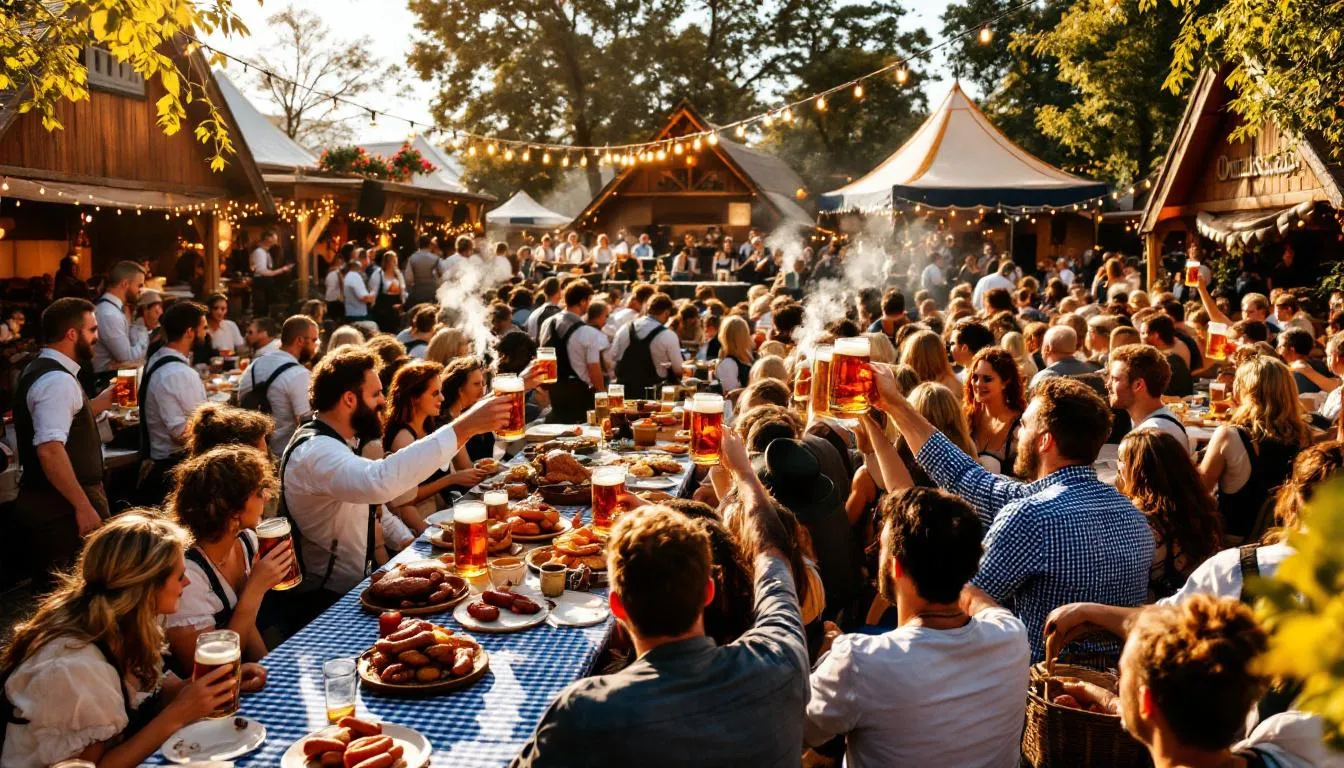
Leave a Reply